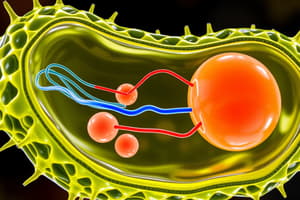Podcast
Questions and Answers
What is a key characteristic of active transport compared to passive transport?
What is a key characteristic of active transport compared to passive transport?
- It does not require any energy.
- It occurs only in gases and solids.
- It moves substances from lower to higher concentration. (correct)
- It can only transport large molecules.
Which process describes water moving into a cell, causing it to swell?
Which process describes water moving into a cell, causing it to swell?
- Exosmosis
- Diffusion
- Endosmosis (correct)
- Osmosis
In which scenario does diffusion occur?
In which scenario does diffusion occur?
- Movement of solvent through a semi-permeable membrane.
- Mixing substances without a membrane. (correct)
- Flow of water in one direction only.
- Transport of large molecules using ATP.
Which statement is true regarding the flow of substances in osmosis versus diffusion?
Which statement is true regarding the flow of substances in osmosis versus diffusion?
How can the process of osmosis be stopped?
How can the process of osmosis be stopped?
What characteristic defines an organism as unicellular?
What characteristic defines an organism as unicellular?
Who first discovered and named the cell?
Who first discovered and named the cell?
Which of the following statements is NOT a part of cell theory?
Which of the following statements is NOT a part of cell theory?
What term refers to the substance within a cell that is surrounded by the cell membrane?
What term refers to the substance within a cell that is surrounded by the cell membrane?
Which scientist is credited with discovering the cell nucleus?
Which scientist is credited with discovering the cell nucleus?
Flashcards are hidden until you start studying
Study Notes
Active and Passive Transport
- Passive Transport: Movement of substances from high to low concentration without energy expenditure.
- Active Transport: Movement of substances from low to high concentration requiring energy (ATP).
- Osmosis: The passage of water molecules across a semi-permeable membrane from a solution with a high concentration to a solution with a lower concentration.
- Endosmosis: Water molecules enter the cell, causing it to swell.
- Exosmosis: Water molecules move out of the cell, causing it to shrink.
- Diffusion: Movement of a substance from an area of high concentration to an area of low concentration, seeking to spread uniformly.
- Types of solutions: Solutions can be classified based on the concentration of solute compared to the cell:
- Hypotonic: lower concentration of solute outside the cell, water enters the cell
- Hypertonic: higher concentration of solute outside the cell, water leaves the cell
- Isotonic: equal concentration of solute inside and outside the cell, no net movement of water
Cell Structure
- The Cell: The structural, functional, and biological unit of all living beings.
- Cell Theory:
- All living organisms are composed of cells.
- Living organisms could be made up of one or more cells.
- New cells arise from pre-existing cells through the process of cell division.
Cell Diversity
- Unicellular Organisms: Organism made up of a single cell, e.g., bacteria, protozoa.
- Multicellular Organisms: Organism made up of more than one cell, e.g., humans, animals.
Cell Discoveries
- Robert Hooke (1665): Discovered and named the cell.
- Anton van Leeuwenhoek (1674): Discovered protozoa and bacteria, living cells.
- Robert Brown (1831): Discovered the cell nucleus.
- Schleiden and Schwann (1838, 1839): Proposed the cell theory.
- Purkinje (1839): Discovered protoplasm (the living content of the cell).
Cell Wall
- Non-living, rigid outer covering of plant cells composed mainly of cellulose.
- Provides structural strength, lies outside the plasma membrane.
- Plasmolysis: Shrinkage of cell contents away from the cell wall due to water loss through osmosis.
- Functions:
- Permits plant, fungi, and bacterial cells to resist bursting in hypotonic environments.
- Allows plants to absorb water by osmosis, leading to swelling and pressure against the cell wall.
- The cell wall exerts equal pressure against the swollen cell, preventing bursting.
- Cells with walls can endure greater changes in the surrounding medium than animal cells.
Nucleus
- The nucleus contains the cell's genetic material (DNA), organized into chromosomes (DNA and protein).
- DNA molecules contain the information essential for constructing and organizing cells.
- The nuclear membrane is double-layered and contains pores for material exchange between the nucleus and cytoplasm.
- The nucleus plays a central role in cellular reproduction and development by directing chemical activities and determining cell maturity.
Mitochondria
- Double membrane-bound organelles, the "powerhouses" of the cell.
- Inner membrane is folded into cristae, increasing surface area for ATP generation.
- Mitochondria produce ATP, the cell's energy currency, used for various cellular activities and mechanical work.
- They possess their own DNA and ribosomes, enabling protein synthesis.
Plastids
- Exclusive to plant cells, existing in two varieties: chromoplasts and leucoplasts.
- Chromoplasts: Colored plastids, responsible for the colour of flowers.
- Chloroplasts: Contain chlorophyll, enabling photosynthesis and regulating atmospheric oxygen levels.
- Leucoplasts: Non-colored plastids, function as storage sites for starch, oils, and protein granules.
Ribosomes
- Membrane-less cell organelles involved in protein synthesis.
- Present in both prokaryotic and eukaryotic cells.
- Key functions:
- Manufacture protein molecules.
- Manufacture enzymes.
- Manufacture hormones.
Vacuoles
- Storage sacs in cells, small in animals, large in plants.
- Plant Central Vacuole: Occupies 50-90% of cell volume, filled with cell sap.
- Functions:
- Provide turgidity and rigidity to plant cells.
- Store essential substances.
- Contents:
- Amino acids
- Sugars
- Proteins
- Consumed food items (in single-celled organisms)
- Specialized roles:
- Expelling excess water and wastes from unicellular organisms.
Endocytosis and Exocytosis
- Endocytosis: Taking in substances into the cell.
- Exocytosis: Removing substances from the cell.
Lysosomes
- Small, membrane-bound organelles, sometimes called "suicide bags" due to their role in breaking down organic material.
- Involved in breaking down all organic material, including bacteria, old organelles, and waste products.
- Important for intracellular digestion.
Golgi Apparatus
- A stack of flattened, membrane-bound sacs, involved in processing and packaging proteins and lipids.
- Modifies and packages proteins and lipids for transport within the cell or secretion outside the cell.
- Plays a key role in the formation of lysosomes.
Cell Division
- The process of cell division gives rise to new cells for growth, cell replacement, and reproduction.
- Two main types of cell division:
- Mitosis: Division of the nucleus resulting in two identical daughter cells.
- Meiosis: Division process that produces gametes (sperm and egg cells) with half the number of chromosomes.
Comparison of Plant and Animal Cells
| Feature | Plant Cell | Animal Cell |
|---|---|---|
| Cell Shape | Square or rectangular | Irregular or round |
| Cell Wall | Present | Absent |
| Plasma/Cell Membrane | Present | Present |
| Endoplasmic Reticulum | Present | Present |
| Nucleus | Present, lies on one side of the cell | Present, lies in the center of the cell |
| Lysosomes | Present but very rare | Present |
| Golgi Apparatus | Present | Present |
| Cytoplasm | Present | Present |
| Ribosomes | Present | Present |
| Plastids | Present | Absent |
| Vacuoles | Few large or a single, centrally positioned | Usually small and numerous |
| Cilia | Absent | Present in most of the animal cells |
| Mitochondria | Present but fewer in number | Present and numerous |
| Mode of Nutrition | Primarily autotrophic (photosynthesis) | Heterotrophic (ingestion of food) |
Studying That Suits You
Use AI to generate personalized quizzes and flashcards to suit your learning preferences.




